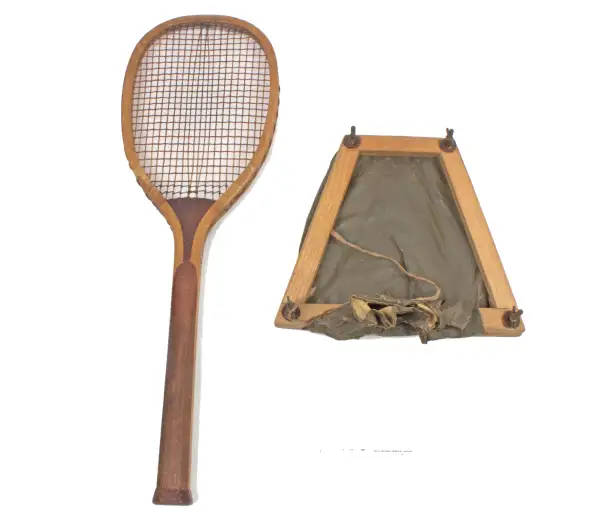Wood possesses a unique charm that resonates with authenticity and timelessness, evident in various items like boats, toys, furniture, and for tennis aficionados, wooden racquets.
Stephen Murphy, a former Seniors pro and the founder of the Wood Tennis Club, remarks, “Players appreciate the feel and sound of wood, the craftsmanship, and the aesthetic allure of the timbers.”
Operating out of Adelaide, Australia, Murphy collaborated with Grays International, a renowned sports manufacturer from England, to reintroduce the classic wooden tennis racquet. The idea sparked when he discovered that Grays still retained the capability to produce wooden racquets, even three decades after they became commercially obsolete.
Grays, the oldest existing producer of wooden racquets globally, preserved the jigs and equipment used to craft the traditional wooden frames, unlike other manufacturers.
Richard Gray, CEO of the family-run enterprise, recalls, “We initially revived the wooden racquets for Bjorn Borg’s attempted comeback in 1991.”
After retiring in 1984, the legendary Swede returned to the professional circuit at the 1991 Monte Carlo Open, wielding a personalized Grays wooden racquet. Despite his efforts, Borg lost to Spain’s Jordi Arrese in straight sets, failing to progress to the second round.
Borg struggled to win a single set in his first nine comeback matches, facing challenges from composite racquets that offered superior power and spin.
Nevertheless, Grays, a leader in sporting equipment and premium wooden frames since 1855, never lost its passion for wood. Based in Cambridge since its inception, Grays built a reputation for crafting cricket bats, field hockey sticks, and lawn tennis racquets, gaining recognition among University players.
Gray elaborates, “Our racquets are handmade in Cambridge using tried and tested laminations of timber from various English trees that we cut and process ourselves.”
Early Grays racquets were endorsed by stars like Max Woosnam, an English gold medalist at the 1920 Olympics and champion at the 1921 Wimbledon doubles tournament. Even King George VI, during his time at Cambridge, was a regular user of Grays racquets.
Today, Grays focuses more on producing equipment, clothing, and protective gear for its internationally recognized brands in cricket, rugby, and field hockey. “Wooden racquets remain a small but significant part of our business, honoring the legacy of our founder,” says the CEO.
The centuries-old tradition of using wood in tennis racquets has its own rich history before being replaced by materials like aluminum, steel, fiberglass, boron, kevlar, and graphite. The racquet, a primary tool in a player’s arsenal, traces its origins to the 16th century when an early form of tennis, resembling squash, was played indoors.
Initially, the racquet head was small and tilted, allowing players to scoop low bouncing balls off the floor and walls. As the game evolved, the head became larger and symmetrical, the wood thinner, and the grip wrapped in leather.
One of the earliest enhancements to the wooden structure was Spalding’s 1905 patent for a locked wedge inserted into the racquet’s throat to reinforce its weakest point.
In 1915, the Bancroft Company patented a 3-ply laminated racquet, featuring a leather strip sandwiched between two wooden layers, enhancing strength and flexibility.
By the 1930s, racquet construction involved multiple thin layers glued together under pressure, increasing stability and reducing weight.
Tennis historian Richard Naughton highlights Australia’s influence on wooden racquets due to the sport’s popularity there. “Unlike in the U.S., many top amateur players had ties with racquet companies or sports manufacturers,” he notes.
Jack Crawford, equipped by a Tasmanian racquet maker, popularized the flat top design during his grand slam victories in the early 1930s, despite its antique status.
Laminated racquets thrived from the 1940s to the 1960s, with some featuring up to 18 layers of ply strips. Decorative paint, decals, and varnish catered to diverse consumer preferences.
By the late 1970s, composite racquets gained popularity among recreational players and professionals, offering improved aerodynamics and durability.
This shift marked the decline of renowned wood makers like Donnay in Belgium and Bancroft in the U.S., which eventually ceased to exist as independent entities.
Some professionals extended the use of wooden racquets in competition. John McEnroe and Chris Evert won the US Open in 1980 and 1981, respectively, with laminated wood racquets.
In 2019, Murphy and Grays introduced the ‘Masterpiece’, believed to be the first commercially produced all-wood racquet in over 30 years. The limited edition of 100 frames sold out swiftly.
The ‘Masterpiece’ was succeeded in 2022 by the ‘Masterpiece International’, featuring similar construction but different aesthetics, and ‘The Wingfield’, honoring Major Walter Wingfield, the ‘Father of Lawn Tennis’.
This year, they launched the ‘Mystique’, inspired by the model made for Borg during his comeback. All Grays racquets, sold in 15 countries, are strung in the UK by Paul Skipp, head stringer at Wimbledon.
Grays promoters and exhibitors include former pros like Mikael Pernfors (1986 French Open finalist) and Fred Stolle (1965 French Open and 1966 US Open champion), who also serves as the Wood Tennis Club’s ambassador.
Murphy acknowledges that today’s pros are unlikely to adopt wooden racquets on the Tour, as their unique touch and feel differ from the modern game.
He envisions wood tennis tournaments as a distinct form of the sport, akin to beach tennis or wheelchair tennis. This year, Murphy is organizing the inaugural Australian Wood Tennis Championships in November.
“I aim to preserve the heritage of all-wood racquets and dispel the notion that they require enhancement by other materials to be exceptional racquets,” he asserts.
Grays racquets are priced starting at £205 (approximately $256) and can be ordered through direct requests on the Facebook pages of Wood Tennis Club or Grays Wood Tennis.
